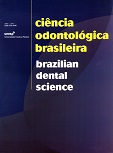Análise Fotoelástica das Tensões Geradas por Transferência em Implantes Osseointegrados.
DOI:
https://doi.org/10.14295/bds.2010.v13i3/4.360Keywords:
Fotoelasticidade, Implante Dentário Endoósseo, Técnica de Moldagem Odontológica.Abstract
A proposta deste trabalho foi avaliar cinco técnicas de transferência: GI: transferentes quadrados unidos com resina acrílica Duralay em monobloco; GII: transferentes quadrados unidos com resina acrílica Duralay e seccionamento; GIII: transferentes quadrados unidos com resina acrílica Pattern Resin em monobloco; GIV: transferentes quadrados unidos com resina acrílica Pattern Resin e seccionamento; GV: transferentes quadrados unidos com Pattern Resin e haste metálica. Foram utilizados blocos de resina fotoelástica, compostos de dois implantes cada simulando uma prótese fixa posterior de três elementos. Os transferentes foram entrelaçados com fio dental e em seguida, unidos com as resinas acrílicas, ou apenas resina e haste metálica. A análise das tensões geradas sobre os implantes foi realizada com o auxílio de um polariscópio circular acoplado a uma câmara digital fotográfica. Foram avaliadas as regiões cervicais e apicais dos implantes por meio de análises qualitativas e quantitativas das franjas fotoelásticas geradas após a união dos transferentes. Quantitativamente, os resultados foram estatisticamente insignificantes. Qualitativamente, o grupo que apresentou o maior número de tensões foi GI, seguido pelo GIII. Para os demais grupos não foram observadas tensões. Concluiu-se que as técnicas de transferência com reforço metálico e de seccionamento geraram menores tensões sobre os implantes.
Downloads
Downloads
Published
How to Cite
Issue
Section
License
Brazilian Dental Science uses the Creative Commons (CC-BY 4.0) license, thus preserving the integrity of articles in an open access environment. The journal allows the author to retain publishing rights without restrictions.
=================




























